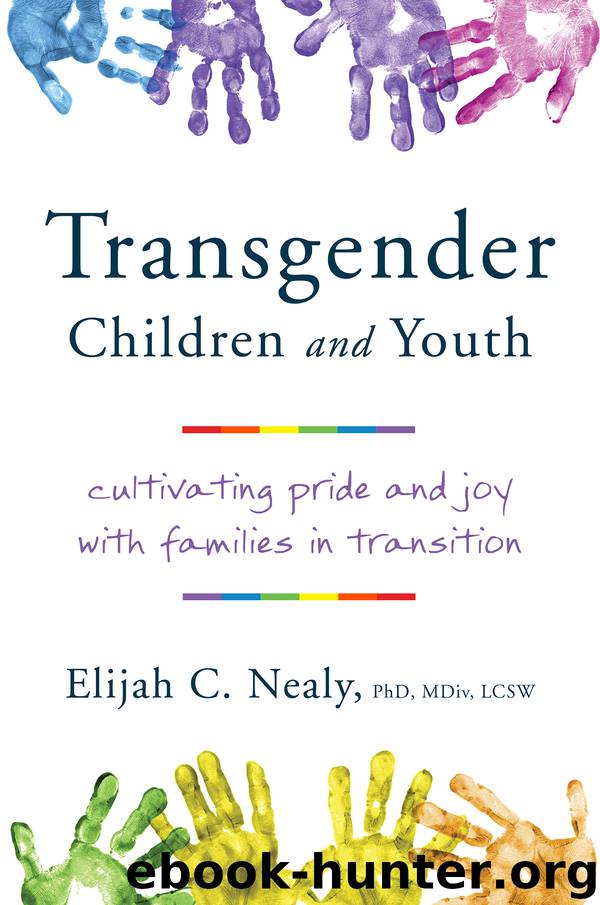Transgender Children and Youth by Elijah C. Nealy

Author:Elijah C. Nealy
Language: eng
Format: epub
Publisher: W. W. Norton & Company
Published: 2017-04-08T04:00:00+00:00
Coming Out at School
It can be helpful to begin a child’s social transition at school on the first day back from a break in classes. When possible, many families choose to have their child or adolescent socially transition with the start of the school year in September. This creates a fresh start with new teachers, who meet the young person in their affirmed gender and begin using their affirmed name and pronouns at the onset of the academic year. This can facilitate the consistent use of the youth’s affirmed name and pronouns more smoothly as opposed to the teacher needing to shift to a new name midway through the year.
However, decisions about when a young person or family is ready to transition at school do not always fit this timetable. Some families begin social transition after the December/January break or upon returning from spring break. While teachers and classmates knew the young person in their birth-assigned gender and name for part of the school year, beginning after a break in classes creates a clear first day when the new affirmed gender is announced and recognized.
Other families simply agree on a start date with the school without connecting it to a school break (typically on Monday at the start of a new week). For preschool and elementary school youth, it may be less critical to begin a school transition in conjunction with the return from a break. Younger peers typically make the shift to a child’s new name and affirmed gender more easily, without extensive explanations or discussion.
There are situations when the young person can begin going by their affirmed gender when they start a new school. This might be at the beginning of middle or high school. Some families relocate or find other ways for their child to have a complete new beginning in their affirmed gender, with neither teachers nor classmates having known the child prior to their social transition. At times, this choice is made because the parents and young person do not perceive the current school environment as supportive of transgender youth. Other times, the young person does not want to navigate, or feel capable of navigating, the disclosure and adjustment period that occurs when trans youth socially transition in a school where they were previously known in their birth-assigned sex/gender.
Download
This site does not store any files on its server. We only index and link to content provided by other sites. Please contact the content providers to delete copyright contents if any and email us, we'll remove relevant links or contents immediately.
| African-American Studies | Asian American Studies |
| Disabled | Ethnic Studies |
| Hispanic American Studies | LGBT |
| Minority Studies | Native American Studies |
Cecilia; Or, Memoirs of an Heiress — Volume 1 by Fanny Burney(32075)
Cecilia; Or, Memoirs of an Heiress — Volume 3 by Fanny Burney(31469)
Cecilia; Or, Memoirs of an Heiress — Volume 2 by Fanny Burney(31419)
The Great Music City by Andrea Baker(30797)
We're Going to Need More Wine by Gabrielle Union(18643)
All the Missing Girls by Megan Miranda(14789)
Pimp by Iceberg Slim(13800)
Bombshells: Glamour Girls of a Lifetime by Sullivan Steve(13700)
Fifty Shades Freed by E L James(12926)
Talking to Strangers by Malcolm Gladwell(12889)
Norse Mythology by Gaiman Neil(12861)
For the Love of Europe by Rick Steves(11558)
Crazy Rich Asians by Kevin Kwan(8898)
Mindhunter: Inside the FBI's Elite Serial Crime Unit by John E. Douglas & Mark Olshaker(8722)
The Lost Art of Listening by Michael P. Nichols(7170)
Enlightenment Now: The Case for Reason, Science, Humanism, and Progress by Steven Pinker(6879)
The Four Agreements by Don Miguel Ruiz(6326)
Bad Blood by John Carreyrou(6285)
Weapons of Math Destruction by Cathy O'Neil(5848)
